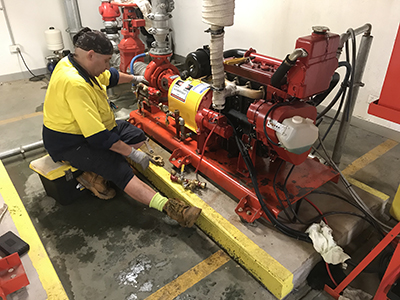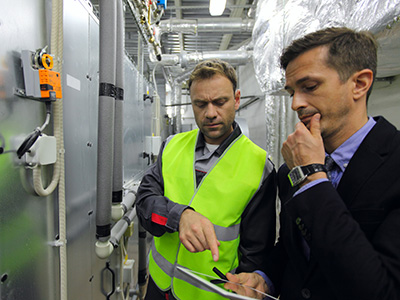A Fire & HVAC Maintenance Short Cut to Avoid
An uncomfortable conversation.
A little bit about us

We look after buildings, be they residential strata apartment blocks, Commercial, Retail, industrial, CBD Hotels, Clubs, and so forth. Our Prime core business is in the trades and technical services, in particular Fire protection services, HVAC Mechanical Services, Electrical Services (General and mechanical), Building and Building Automation.
These all have synergies within a building and often rely upon each other in essential services or fire mode.
Hence, with the team we have now, we are able to offer a single holistic maintenance service.
Now, to the Story
We were on a site, just outside the Sydney CBD, about ten years old, to perform Fire Protection Maintenance Services in conjunction with the HVAC mechanical services. The building was an apartment block with more than 150 units, a gym, a pool, and a large parking lot in the basement.
The HVAC and Fire systems work together in providing essential services for the apartment building, so it made sense to have the same team look after both, especially at the Annual Fire Safety Statement (AFSS) time.
So we began our walk around the site with the on-site building manager.
Site Inspection | Fire & HVAC Maintenance Short Cuts to Avoid
The perspective we had, is this, we’re trying to gauge how much labour time is involved in the job and if we have to consider after-hours work, especially being an apartment block.
As a part of our quote for these works, we include “sign off” on the safety performance measures of the Annual Fire Safety Statement each year and submit the AFSS to the local Council and the fire brigade.
We consider all the safety measures, including mechanical services such as fire dampers and fire stair pressurization in our maintenance/inspection and testing regime for the site.
Our walk-through is to gauge the time required for our technicians to perform the monthly maintenance, six-monthly maintenance, and perform AFSS, including testing all the safety measures and full-function fire test, amongst other tasks.
In My Head
Now consider stepping into the danger zone of what is going on inside my head as we walk around the site with the client’s building manager; here is a short list of what I’m thinking:

• How old is the site, and how has it been looked after?
• How compliant is the site now?
• Are there current logbooks that have been completed by others?
• Are there any current critical defects listed in the logbooks
• Are these logbooks recording existing faults?
• Are there any fire zone isolations, and why?
• What is the condition of the existing equipment and systems, e.g. fire doors, portables, hose reels, hydrant valves, etc? Am I really trying to assess the current condition of the protection and mechanical services of the site?
• What are the critical dates, and how close are we to them?
• Are there any major projects happening presently?
• etc
Keeping in mind, there is no mention of the price or any scope of work details at this point in our walk with the building manager.
Here’s where it becomes interesting.
The Building Manager’s Attitude
We note to the building manager the Evacuation diagram is well over five years old. We explain that evacuation diagrams should be updated every five years by an appropriately qualified team. A team who knows the standards and knows the changes in standards since this evacuation diagram was last printed and installed.
“oh no,” he said, “we will just photocopy it and change the date.”
We explained the dangers behind such behaviour, and through this discussion, we discovered the Building Manager is a member of the committee and wanted to save money.
Conflict of Interest | HVAC Maintenance Short Cuts to Avoid
The conflict of interest, in this example, is when the building manager has a financial interest and a keen desire to be seen as a bit of a “hero” by the committee. We empathize with his desire for success in the budget, but this attitude will have an indirect insurance risk and a genuine risk to property and life.
How far will this building manager go to save a dollar, and what makes his judgment correct at the limitations he sets, over and above the Australian Standards and the legislation? He is not an engineer, a scientist, or even a tradesperson. (his background was, in fact, accounting, hence the attention to the budget).
Continuing Our Site Inspection

Continuing along on our site walk, we then noted a couple of emergency lights that were “out.”
“we’ll get the handyman to fix that,” he said.
Then we noted several smoke detectors, which were covered in thick dust from a nearby Air conditioning outlet.
“we’ll get the handyman to dust that off” (and generate a few false alarms, no doubt)
(we saw the Supply air fan also had not had a change of filter for some time)
Then we noted a Fire Door; the laminates were peeling off at the bottom.
“we’ll get the handyman to fix that; he’ll sand it back and glue it down.”
Insert expletive here!
We explained the dangers of what he was doing, the conflict with the Australian standards and, that the doors would not be signed off on the AFSS; we explained the Emergency Lights should be repaired by an electrician (preferably with an FPAS accreditation), and many others items too many to mention here.
The compromised safety standards he was putting the occupants in, including his beloved committee member colleagues, was clearly evident as we found other issues which required greater attention.
Desk top Annual Fire Safety Statement
What was really going on was this building manager wanted us to sign off on all the safety measures of the AFSS at our desk and say everything was ok, while he took care of the maintenance and the repairs. This wasn’t going to happen.
The building manager was looking to save a dollar and had absolutely no respect for why the systems were in place and why legislation is written the way it is. To protect the innocent victims, including his committee member colleagues, from tragedy from these dangerous cost-saving strategies.
Add to this the false economics of “band-aiding” repairs instead of performing corrective maintenance properly, but that’s for another day.
The unthinkable
There is something else here, and that is insurance. As a company, we specialize in these essential services, and we have a duty of care to the customer to perform the work in a compliant manner, to Australian Standards and codes. And we are insured for such work.
Should the unthinkable happen, we arrive at the Coroners Court with logbook copies, quotes that were accepted and quotes that were refused, we have emails explaining to the customer the risk if the works are not done, critical and non-critical defects, we have photos, and so forth.
As an independent third party providing these essential services, we cover ourselves and ensure we provide compliant services, including documentation, all of which covers our clientele.
What will happen when this building manager answers to the judge in the same court?
Our Best Clients
But wait, not all building managers are the same. There are many who are on the committee who are very proactive in getting things done. We have many building managers who have a “just fix it” attitude but will be very demanding of compliance and all the relevant documentation for the same reasons, set out above.
They are keen to protect themselves, their committee members, and their community. We help support and protect them with maintenance, compliance, and documentation.
Thank you for reading.
Nigel Wraight
FORTE ASSET SERVICES Pty Ltd



Comment *I am Strata Chairmen of a block of seven t/houses three years old and the strata had to replace the Exhaist system in the garage recently at a cost of some $15,000 after a battle with the Builder and after Inspections by the Dept, Fair Trading. Now we are quoted $1,600 per half year for calibration of the CO2 monitor,Do you charge this much?
Hi Trevor,
no we charge circa $480 + GST for the first 2 sensors then typically $110 + GST per sensor after that. For example a site with 9 sensors would be $480 + $770 + GST. Also note not all sensor require 6 months calibration. “6 months or as per OEM Recomendations”. My apoloigies for the late reply – direct email is nigel@forteas.com.au
thank you